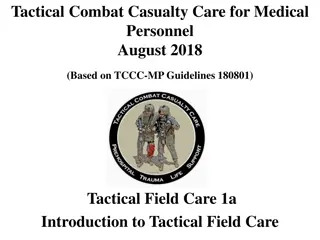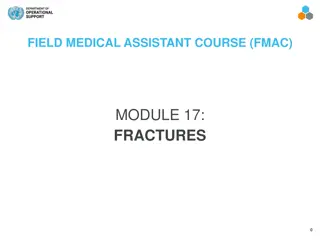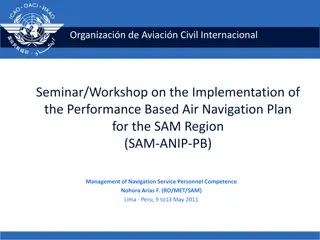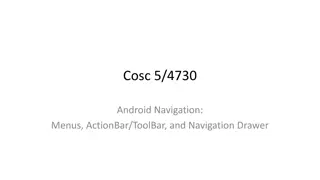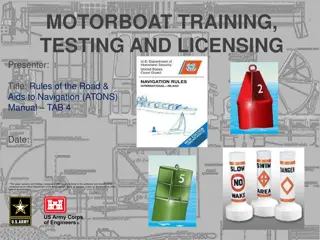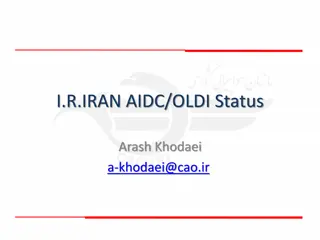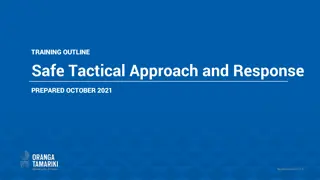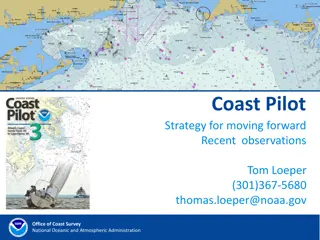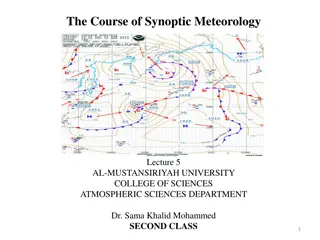Understanding TACAN: Tactical Air Navigation System Overview
TACAN, Tactical Air Navigation, is a precise navigation system used by military aircraft, providing distance and bearing information from ground stations. It offers more accuracy than VOR-DME systems, catering to both military and civil aviation needs. Through TACAN equipment, pilots can determine the direction and distance to specific locations, aiding in navigation and flight path adjustments. The system operates based on radar-ranging principles, measuring slant range and utilizing twin-pulse decoders for efficient signal transmission and reception.
Download Presentation

Please find below an Image/Link to download the presentation.
The content on the website is provided AS IS for your information and personal use only. It may not be sold, licensed, or shared on other websites without obtaining consent from the author. Download presentation by click this link. If you encounter any issues during the download, it is possible that the publisher has removed the file from their server.
E N D
Presentation Transcript
TACAN TACticalAir Navigation Clinton Kris P. Idea BS EcE 5
TACAN Overview Principles Operation TACAN Equipment
OVERVIEW TACtical Air Navigation is a navigation system used by military aircraft.It provides the user with a distance and bearing from a ground station. It is a more accurate version of the VHF omnidirectional range / Distance Measuring Equipment (VOR-DME) system that provides range and bearing information for civil aviation. At VORTAC facilities,the DME portion of theTACAN system is available for civil use. With that: Provides continuous range and bearing 100 aircraft can receive range at one time No limit of aircraft receiving bearing information Signal sent to ground station Signal sent back to airplane TACAN equipment required
OVERVIEW One meter indicates, in nautical miles, the distance of the aircraft from the surface beacon. The other meter indicates the direction of flight, in degrees-of-bearing, to the geographic location of the surface beacon. By using the TACAN equipment installed in the aircraft and TACAN ground equipment installed aboard a particular surface ship or shore station, a pilot can obtain bearing to and distance from that location.He or she can then either: (1) fly directly to that particular location,or use the bearing and distance from a specific beacon to fix his or her geographic location. (2)
PRINCIPLES The distance measuring concept used in TACAN equipment is an outgrowth of radar-ranging techniques. Radar-ranging determines distance by measuring the round-trip travel time of pulsed rf energy. The return signal (echo) of the radiated energy depends on the natural reflection of the radio waves. However, TACAN beacon-transponders generate artificial replies instead of depending on natural reflection. TACAN Slant Range TACAN measures distance in slant range Slant range = straight-line-of- sight Directly over the station DME measures height above ground
PRINCIPLES TACAN Slant Range
PRINCIPLES TACAN PULSE PAIRS TACAN transponders use twin-pulse decoders to pass only those pulse pairs with the proper spacing.The purpose of this twin-pulse technique is to increase the average power radiated and to reduce the possibility of false signal interference. After the receiver decodes an interrogation, the encoder generates the necessary pulse pair required for the transponder s reply.ATACAN pulse pair generated by airborne or ground equipment
PRINCIPLES TACAN SIGNAL PRIORITIES Priorities have been established for transmission of the various types ofTACAN signals.These priorities are as follows: Reference bursts (North and auxiliary) Identification group Replies to interrogations Squitter Therefore, the identification group, replies, or squitter will be momentarily interrupted for the transmission of either the main or auxiliary reference group. The transmission of replies or squitter will be interrupted every 37.5 seconds during the transmission of an identification code dot or dash.
OPERATION TACAN in general can be described as the military version of the VOR- DME system. It operates in the frequency band 960-1215 MHz. The bearing unit of TACAN is more accurate than a standard VOR since it makes use of a two frequency principle,with 15 Hz and 135 Hz components. The distance measurement component of TACAN operates with the same specifications as do civil DME's. Therefore to reduce the number of required stations,TACAN stations are frequently co-located with VOR facilities.These co- located stations are known as VORTAC's. This is a station composed of a VOR for civil bearing information and a TACAN for military bearing information and military/civil distance measuring information. The TACAN transponder performs the function of a DME without the need for a separate, collocated DME. Because the rotation of the antenna creates a large portion of the azimuth signal, if the antenna fails, the azimuth component is no longer available and theTACAN downgrades to a DME only mode.
OPERATION FlightGear A few planes in FlightGear are equipped with TACAN. Here's a list of known aircraft with TACAN: A 6E A 10
OPERATION FlightGear A few planes in FlightGear are equipped with TACAN. Here's a list of known aircraft with TACAN: A4F j Blackburn Buccaneer
OPERATION FlightGear A few planes in FlightGear are equipped with TACAN. Here's a list of known aircraft with TACAN: Grumman F-14 Tomcat Lightning
OPERATION FlightGear A few planes in FlightGear are equipped with TACAN. Here's a list of known aircraft with TACAN: Northrop T38
TACAN EQUIPMENT Many different types of TACAN equipment have been used for air navigation. Today, the AN/URN-25 is taking over the task of tactical air navigation from the older AN/URN-20 on new construction ships and as ships complete overhaul. TACAN SET AN/URN-25 The AN/URN-25 TACAN is used as a ground-based or shipborne beacon transponder to provide range and bearing information to aircraft equipped with TACAN equipment. It consists of two major units: the Transponder Group OX-52/URN-25, commonly referred to as unit 1, and the Control-Indicator C-10363/URN-25, commonly referred to as unit 2.These units are shown in figure 2-7.Each transponder is housed in a cabinet with two vertical drawers, one containing a coder keyer and the other containing a receiver-transmitter. The control-indicator displays the status of the transponder(s) and failure alarms, and allows limited control of the transponder(s) from a remote location It may be mounted in its own cabinet or in a standard 19-inch rack. To increase the channels available,the TACAN set can be operated in either the X or Y mode.The Y mode changes the pulse pair spacing and the auxiliary burst count and spacing, and increases system delay.


